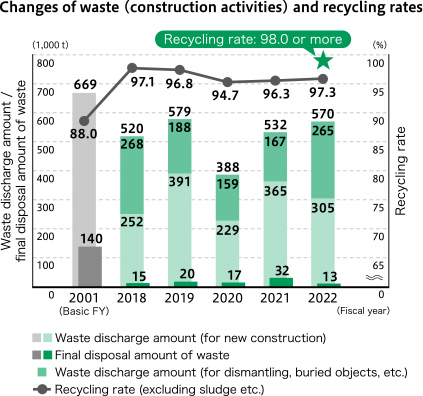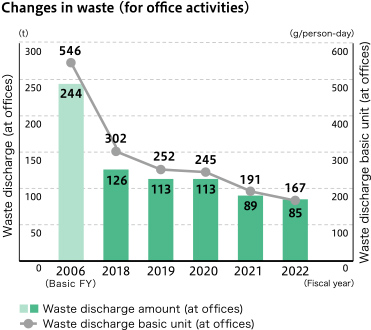Recycling-oriented society construction: Measures against construction waste
Policy/view
Using approximately 40% of sources of the overall industry in Japan, the construction industry discharges approximately 20% of waste. Also, in terms of a global view, the response to international movements, such as the conversion into the circular economy (CE), which is a business model based on resource circulation in Europe, and the marine plastics problem, is required.
The Ministry of Land, Infrastructure, and Transport made public the “Construction recycling promotion plan 2020 - for recycling considering ‘quality’ important” in September 2019. Since the recycling rate, which shows that we have entered a maintaining/stable period in terms of the recycling rate, the improvement of recycling “quality” is considered an important perspective in the future.
The “study of a scheme to recycle asphalt concrete mass into recycled asphalt with higher added value” has become a common issue between our company, which is a discharge company, and the Maeda Road Construction in the same group. Also, the “measures for waste plastic derived from petroleum” and the “matching system in which the public and private sectors effectively use construction-generated soil” have an aspect as global warming mitigation measures.
Making efforts for environmentally friendly design through products’ life cycles to realize recycling economy from multiple perspectives of an infrastructure operator (ordering party), a discharge company/recycling trader, and others, our company’s group proceeds with approaches to construction materials manufacturers through the industry. We will also continue to address reducing the number of reports to administrations and deploy productivity improvement measures in society by unifying resource/by-product physical distribution data.
Management
We are working on environmental management in accordance with the implementation plan for three years based on the results obtained by FY 2021.
As for individual efforts, we quarterly held WG with the Building Dept. and the Civil Engineering Dept. to consider measures. Also, the director of CSR and the Environment Dept. collates and reports to the top management the implementation status of environmental efforts that have been made by departments including the Procurement Dept. and Engineering Dept. In addition, a management review is held at the end of the fiscal year, and matters such as annual goals are summarized.
The risk management at a field office is carried out through the observance of the rules for byproduct measures prescribed by environmental education and EMS, etc., inspections by the list of regulations, etc. at the construction stage, and the internal audit and environmental patrol by a supervisory department of the branch.
Also, for the promotion of environmental efforts, we are seeking to visualize those efforts by understanding the results through the environmental portal site and converting the efforts on the site into an environmental value.
Goal and result
The recycling rate has continued to remain at approximately 96%. Therefore, we have changed the control index in the medium-term environmental plan to an individual recycling rate for new building construction works in order to achieve a zero final disposal volume (100% recycling rate). The efforts to improve the recycling rate of waste plastic especially will be strengthened.
The total emissions in FY2022 were 570,000 tons, an increase of 38,000 tons from the previous fiscal year. The reduction target for the emissions basic unit of mixed waste in the housing construction sector was not achieved. We will promote the reduction of mixed waste by the deployment of the separation management system, etc. Also, regarding in-office activities, we are working on the reduction of waste discharge and water consumption. The basic unit amounts per person increased in FY 2022 compared with the previous fiscal year.
Reduction of total discharge and mixed waste discharge at the construction stage
The basic matters to reduce waste (suppression, separation, etc.) are specified in the “environment version of the MAEDA rule,” and good practices of efforts are classified by categories and deployed internally. Also, the management system using personal digital assistants such as iPads is introduced, and the reduction of mixed waste and the laborsaving of employee waste management activities are being conducted.
Recycling of waste plastic
At field offices, the suppression of waste generation, the recycling / discharging by separation on-site and the public-private matching for soil generated from construction are underway as measures against construction byproducts. The total recycling rate, including the rate for heavy loads such as concrete mass, has remained approximately 97% in recent years. However, to achieve a recycling rate of 100% for new building construction, it is necessary to review measures for each item.
From FY 2019, we revised the environment version of the MAEDA rule, and added items for waste plastics ((i) separation of soft and hard plastics, (ii) individual separation of vinyl chloride and other similar materials, and (iii) thorough implementation of foreign material removal). The recycling rate of waste plastic in FY2022 was 77.7%, a decrease from FY2021. We will continue to promote efforts. For field offices, we will pursue direct shipment to recycling facilities and wide-area certification facilities. For the head office and branches, we will place focus on the checking of the content of treatment at intermediate treatment facilities (whether a recycling plant or a subcontractor for recycling is available) and recommendation of good facilities.
We are also working on consideration of the use of new materials as alternatives to plastics through the ICI General Center.
Using a wide-area certification system (manufacturer recycling)
The efforts in cooperation with construction materials manufacturers are underway for recycling byproducts generated from construction works as resources. While gypsum wallboard is widely known as an insulation material, as well as tile carpets, etc., the zero final disposal can be achieved by ensuring separate collection at field offices and using the scheme for transporting directly to the manufacturer's factory and recycling them. Since the efforts as an industry are required to develop this certification system, we have taken part in an expert committee of the Japan Federation of Construction Contractors and have promoted the use for its dissemination and development.
The goal of a recycling rate at the construction stage (long-term goal)


![Efforts to construct a recycling-based society: [KPI] Construction stage: Discharge of waste during construction](/assets/images/english/csr/environment/rs/rs_img01.jpg)
![Efforts to construct a recycling-based society: [KPI] Construction stage: Recycling in construction (excluding sludge etc.*)](/assets/images/english/csr/environment/rs/rs_img02.jpg)
![Efforts to construct a recycling-based society: [KPI] Construction stage: Mixed waste discharge in construction (limited to new construction of a building)](/assets/images/english/csr/environment/rs/rs_img03.jpg)

![Efforts to construct a recycling-based society: [KPI] Office activities: Non-industrial waste discharge at offices](/assets/images/english/csr/environment/rs/rs_img05.jpg)
![Efforts to construct a recycling-based society: [KPI] Office activities: Water consumption at offices](/assets/images/english/csr/environment/rs/rs_img06.jpg)
Promotion of the use of an electronic manifesto
We are promoting the use of an electronic manifesto to optimize and simplify the activities to manage information on waste. The utilization factor in the current year is 98%, slightly improved compared to the previous fiscal year, but we failed to achieve the target of 100%.
The main factor was that the companies, which are in the vicinity of the related companies or field offices of an ordering party (the transportation cost and CO2 emissions are less), did not respond to an electronic manifesto. It was also found that there were some cases where one ordering party had requested paper management.
In FY 2020, seven branches had a utilization factor of 95% or more, making no improvement from the previous fiscal year. For areas where it is difficult to operate the electronic manifesto system, we are studying a procurement rule intended to respond to individual obstruction factors.

Efforts for soil contamination
Countermeasures works were conducted in 15 cases in FY 2022, and 106,000 tons of nonconforming soil were treated. The nonconforming soil included about 36,000 tons of contaminated soil requiring a legal response.
Our company, as a designated investigation agency based on the Soil Contamination Countermeasures Law, is positively working on all processes, such as planning, investigation, administrative responses, construction, and technology development, to help to maintain and improve the customer’s land property value, to prevent contamination from spreading to the periphery, and to take appropriate countermeasures.
Antipollution measures in which field offices are widely involved
Industrial wastewater management and exhaust gas countermeasures for vehicles and heavy equipment are required in every field office. Installing a notch tank as a standard facility of a field office, prescribing wastewater management, and cooperating with partner companies, we are making efforts to promote the inspection and maintenance of vehicles and heavy equipment.
Efforts/approach for hazardous and chemical substances
Understanding the impact of hazardous and chemical substances (such as asbestos, organic solvent, dioxin, and PCB [polychlorinated biphenyl]) on the global environment, our company controls and treats them appropriately in accordance with laws. The following table shows the used amount of substances subject to the PRTR Act, which was contained in external wall paint and purchased and used by the Tokyo materials center of our company.
* You can check the whole by scrolling horizontally.
| Items | Weight | ||
|---|---|---|---|
| FY 2020 |
FY 2021 |
FY 2022 |
|
|
Xylene |
18.8kg |
22.3kg |
20.4kg |
|
Toluene |
17.3kg |
20.3kg |
23.3kg |
|
Ethylbenzene |
11.6kg |
19.4kg |
18.2kg |
|
Trimethyl benzene |
0kg |
0kg |
0.5kg |
![Promotion of green procurement: [KPI] Procurement of green procurement items (designated 11 items) at the construction stage and procurement of stationery green procurement items at offices](/assets/images/english/csr/environment/rs/rs_img10.jpg)
![Promotion of green procurement: [KPI] Green procurement amount at the construction stage (30 items)](/assets/images/english/csr/environment/rs/rs_img11.jpg)